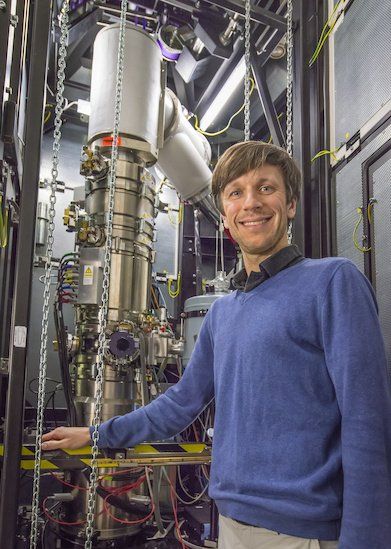Case Study-Fixing Magnetic Field Issue at Lawrence Berkeley National Laboratory
Cancelling magnetic field interference from unknown sources
Electron microscopy is the method of choice in material science and biology research when high resolution imaging is required, however, environmental interference is a common problem that can affect image quality. Scientists at the Lawrence Berkeley National Laboratory (LBNL) are using a Spicer SC24 field cancelling system to help overcome these problems and enhance microscope performance.
LBNL, based in the USA, is a national laboratory with a focus on bringing together multidisciplinary teams of researchers to advance scientific discovery. Within the laboratory is the National Centre for Electron Microscopy – a Molecular Foundry (MF) facility – that houses cutting-edge instrumentation for high resolution imaging and analytical characterization of a broad range of materials, which are available to researchers around the world. Peter Ercius, a MF staff scientist, explained this collaborative environment: “We have eight transmission electron microscopes – three of which are aberration corrected – and each has its own speciality. We offer everything from routine systems to the most advanced, atomic resolution 3D electron tomography. Researchers from any country are able to write a proposal and, if accepted, they are invited to come and use our facilities here, with the support of a team of experts on site.”
Environmental interference limits the performance
Electron microscopes are sensitive pieces of equipment that are susceptible to environmental interference from temperature fluctuations, mechanical vibrations and electromagnetic fields.
These perturbations can shift the electron beam, lowering the image resolution and making it hard to get the most out of the instrument. Peter continued: “Although the newer systems are not as easily affected by interference, it still causes problems and affects the image quality, something that we experienced with one of our own microscopes. The images weren’t as good as I knew the system could produce – having used the same system during my undergraduate degree – objects that were round or should have had a sharp interface looked very jagged, so we knew the beam was unstable.”
“It was apparent from the pattern of our interference that the frequency of the perturbation was 60 Hz, and most likely was being caused by power cables. However, the problem was often intermittent, and we didn’t know exactly where it was coming from, or how to fix the issue, suggesting that there were power surges occurring. The microscope was located at the end of the building, so was more susceptible to outside influences, and was also positioned near a door with a magnetic lock.”
Looking to Spicer for a solution
The facility already used a Spicer magnetic field cancelling system with one of its microscopes, and so the lab contacted Spicer Consulting’s USA distributor, Vibration Engineering Consultants (VEC), to discuss the new problem.
Peter continued: “We also considered a number of other systems, but compared to Spicer they came up short and we decided to invest in a Spicer SC24, primarily because of its ability to cancel AC and DC magnetic fields. VEC helped with the installation and performed a site survey, uncovering that a chiller located near the microscope, and the opening and closing of the outside door were causing some of the interference we were experiencing, but we weren’t able to identify all of the sources.”
“We considered placing all mechanical items on proper isolation padding, in combination with using the field cancelling system. However, installation of the SC24 proved to be a simple solution to a complex problem, significantly improving the image quality. The system is very intuitive, you just turn it on and, at the flick of a switch, the fields are cancelled in all three directions, allowing you to remove any interference. VEC supported us throughout the entire installation and, although there is a lot of expertise in our department, it was great to have additional backup and know-how during the process. We’re so happy that the issue has been overcome, and we are generating images of much higher quality,” concluded Peter.
Spicer Consulting provides solutions to reduce magnetic field interference for higher resolution electron microscopy. Contact us to find out
here.
About Spicer Consulting Limited
Since it was established in 1988, Spicer Consulting has built a world-wide reputation in magnetic field cancelling for Electron Microscopes and similar instruments. Today, working with equipment manufacturers and users alike, the company is recognised as an industry expert in maximising the performance of electron microscopes, electron beam lithography systems, CD metrology and focused ion beam tools.
Spicer Consulting magnetic field cancelling systems protect sensitive equipment in the world's leading laboratories, universities and semiconductor manufacturing plants, as well as in the test facilities of electron and ion beam equipment manufacturers. Its magnetic field, vibration and acoustic analysis systems have been adopted as standard equipment for the conduct of site surveys by leading equipment manufacturers. Spicer Consulting is located in Stewartby, Bedfordshire, within the United Kingdom’s Golden Triangle of elite universities in London, Cambridge and Oxford.
Spicer Consulting Limited, Eden Laboratory, Broadmead Road, Stewartby, Bedfordshire MK43 9ND, England
TEL:+44(0)1234 765773
Email: enq@spicerconsulting.com
© 2023 Spicer Consulting Limited.
All rights reserved. Privacy Notice.
Contact Us
We will get back to you as soon as possible.
Please try again later.


